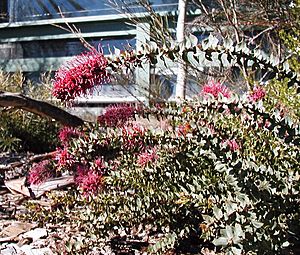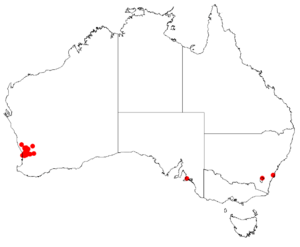Myrtle hakea facts for kids
Quick facts for kids Myrtle hakea |
|
|---|---|
 |
|
| Scientific classification | |
| Genus: |
Hakea
|
| Species: |
myrtoides
|
 |
|
| Occurrence data from AVH | |
The Hakea myrtoides, also known as myrtle hakea, is a special kind of shrub. It only grows naturally in the woodlands of the Darling Range. This hilly area is found near Perth in Western Australia.
What Does It Look Like?
Myrtle hakea is a low-growing bush. It usually reaches about 0.3 to 0.9 meters (1 to 3 feet) tall. This plant has a special woody swelling at its base called a lignotuber. This helps it store food and water, allowing it to survive things like bushfires.
In winter and early spring, you can see beautiful flowers on this plant. They are often mauve, pink, or crimson. These flowers grow in small groups where the leaves meet the branches. After the flowers, small, round, woody seed pods appear. These pods are less than 1 centimeter (0.4 inches) across and have a small, curved tip.
The leaves of the myrtle hakea are stiff and small. They are shaped like an oval and look a bit like the leaves of a myrtle plant. This is why it's called "myrtoides"! Each leaf is about 2 centimeters (0.8 inches) long. They have a clear vein down the middle and end in a sharp point. Sometimes, people graft this plant onto another type of hakea called Hakea salicifolia. This helps it grow well in more kinds of soil.
Its Name and History
This plant was first officially described in 1845 by a scientist named Johann Georg Christian Lehmann. He wrote about it in a book called Plantae Preissianae.
The name myrtoides comes from two parts. "Myrtus" refers to the myrtle plant, and "oides" is a Greek word meaning "similar to." So, the name simply means "similar to myrtle," which describes its leaf shape.
Where It Grows and Lives
Myrtle hakea is a plant that doesn't grow in many places. It's mainly found near Perth, with a few other spots further north in the Victoria Plains area.
It likes to grow in certain types of soil. You can find it in sandy clay that contains laterite (a reddish soil). It also grows near granite rocks and in woodlands where Wandoo trees are common. Because it's so pretty, people often plant it in gardens. It's great for rock gardens or as a ground cover, especially if the soil drains well and it gets plenty of sunshine.
How It's Protected
The good news is that Hakea myrtoides is currently considered "not threatened." This means it's not in danger of disappearing. The Western Australian Government's Department of Parks and Wildlife keeps an eye on its status.

